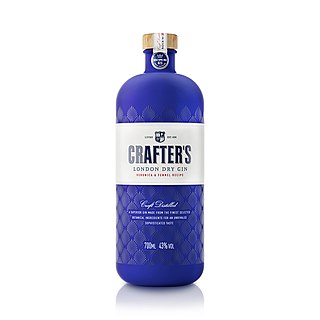
Bombay Sapphire is a brand of gin that is distilled by the Bombay Spirits Company, a subsidiary company of Bacardi, at Laverstoke Mill in the village of Laverstoke in the English county of Hampshire.

Gin is a distilled alcoholic drink flavoured with juniper berries and other botanical ingredients.

Thai Beverage, better known as ThaiBev (Thai: ไทยเบฟ), is Thailand's largest and one of Southeast Asia's largest beverage companies, with distilleries in Thailand, UK, and China. It is owned by Thai Chinese billionaire business magnate Charoen Sirivadhanabhakdi. Listed on the Singapore Stock Exchange, Thai Beverage plc has a market capitalization in excess of US$13 billion.

Feni is a spiritous liquor type originating in Goa, India. The two most popular types of feni are cashew feni and coconut feni. Depending on the ingredients; however, other varieties and newer blends are also sold by distilleries. The small-batch distillation of feni has a fundamental effect on its final character, which still retains some of the delicate aromatics, congeners, and flavour elements of the juice from which it is produced.

Liquor is an alcoholic drink produced by the distillation of grains, fruits, vegetables, or sugar that have already gone through alcoholic fermentation. Other terms for liquor include: spirit, distilled beverage, booze, spirituous liquor or hard liquor. The distillation process concentrates the liquid to increase its alcohol by volume. As liquors contain significantly more alcohol (ethanol) than other alcoholic drinks, they are considered "harder." In North America, the term hard liquor is sometimes used to distinguish distilled alcoholic drinks from non-distilled ones, whereas the term spirits is more commonly used in the UK. Some examples of liquors include vodka, rum, gin, and tequila. Liquors are often aged in barrels, such as for the production of brandy and whiskey, or are infused with flavorings to form flavored liquors, such as absinthe.
Tanqueray is a brand of gin produced by Diageo plc. It originated in London. While it does not command a sizable market share in its native market, its largest market is the United States.

Gordon's is a brand of London dry gin first produced in 1769. The top markets for Gordon's are the United Kingdom, the United States and Greece. It is owned by the British spirits company Diageo. It is the world's best-selling London dry gin. Gordon's has been the UK's number one gin since the late 19th century. A 40% ABV version for the North American market is distilled in Canada.
Rectified spirit, also known as neutral spirits, rectified alcohol or ethyl alcohol of agricultural origin, is highly concentrated ethanol that has been purified by means of repeated distillation in a process called rectification. In some countries, denatured alcohol or denatured rectified spirit may commonly be available as "rectified spirit", because in some countries the retail sale of rectified alcohol in its non-denatured form is prohibited.
La Fée Absinthe is a brand of absinthe, a highly alcoholic, distilled spirit containing the herb wormwood. La Fée Absinthe was created by Green Utopia, which is owned and run by George Rowley.

Hendrick's Gin is a brand of gin produced by William Grant & Sons at the Girvan distillery, Scotland, and launched in 1999. The brand was created by spirits marketer Steven Grasse, while the gin itself was conceived by Lesley Gracie, a Yorkshire native, who was hired by William Grant & Sons to work in new liquid development for some of their products. A decade later she was tasked with creating a new super-premium gin. In addition to the traditional juniper infusion, Hendrick's uses Bulgarian rose and cucumber to add flavour. Hendrick's gin is bottled in a dark brown, apothecary-style bottle.

Beefeater Gin is a brand of gin owned by Pernod Ricard and bottled and distributed in the United Kingdom. Beefeater remained in the control of its founding Burrough family until 1987. The Beefeater distillery is one of 24 in London.

Boodles British Gin is a brand of gin bottled and distributed in the United Kingdom by Proximo Spirits.

Sipsmith is a microdistillery located in London. It is the first copper-pot distillery to open within Greater London' in nearly two centuries. It has been owned by Suntory Global Spirits, an subsidiary of Suntory Holdings of Osaka, Japan, since December 2016.
Sacred Spirits is a microdistillery in Highgate, London. It distills its spirits under a vacuum in glassware, and thus at a lower temperature than traditional pot stills, which operate at atmospheric pressure. The microdistillery operates out of the back room of a residential house, with a vacuum plant in a wendy house in the distiller's back garden. It is an authorised Customs and Excise distillery.
Broker’s London Dry Gin is a brand of gin micro-distilled at a 200-year-old distillery located near Birmingham, England, using a traditional copper pot still.

The London Distillery Company, also known as TLDC, was a distillery based in Bermondsey, London. Originally located in Battersea TLDC produced English whisky, Rye whisky, London gin and British spirits, compounds and cordials. TLDC also created experimental spirits under the TESTBED brand; named after the art space of similar ethos by architect Will Alsop.

Tōkki Soju is a brand of soju founded in Brooklyn, New York in 2016 by master distiller Brandon Hill. The company prides themselves on quality over profit, using expensive ingredients that contribute to taste such as glutinous rice.
Chase Distillery, Ltd. was a British single-estate distillery based in Herefordshire, United Kingdom. William Chase, the former owner and founder of Tyrrells crisps, founded the family-run business in 2008. Using ingredients sourced on-site at Rosemaund Farm, the distillery focuses its production on potato vodka, gin and cider.
Malfy Gin is a brand of gin bottled in Italy, distilled by Torino Distillati, and distributed by Pernod Ricard.

Crafter's is a Nordic gin brand that includes classic London Dry Gin and Aromatic Flower Gin produced by Estonian distillery Liviko. Both gins are handcrafted in Estonia, copper-pot distilled and made in small batches. In 2018 Liviko exported Crafter's gin to 25 countries. The juniper berries used in the making of Crafter's gin are reused in the Re-crafted Crafter's handcrafted beverages, as the berries retain a valuable part of their flavour even after distillation. Liviko was nominated to World Beverage Innovation Award in 2019 for its zero-waste product innovation that lead to a new category of drinks.
















